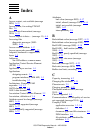Glossary
OSI/FTAM Responder Manual—425199-001
Glossary-22
SCF (Subsystem Control Facility). A utility that provides a common, interactive
management interface for configuring, controlling, and collecting information from
Compaq data communications products.
SCP (Subsystem Control Point). The process used to provide the focal point for all
Compaq data communications subsystems. There can be several instances of this
process. Applications using SPI send all commands for data communications
subsystems to an instance of this process, which in turn sends the commands on to the
manager processes of the target subsystems. SCP also processes a few commands itself.
It provides security features, version compatibility, support for tracing, and support for
applications implemented as NonStop process pairs.
second-level data types. DDL data types made up of one or more first-level data types.
See first-level data types.
security group. File attributes that pertain to security and access control. These
attributes are negotiated at association establishment. The security group attributes are
access control and legal qualifications.
sender. The entity that initiates and sends a communication to a remote receiver.
See receiver.
sensitive command. An SCF command that can be issued only by a restricted set of
Guardian users, such as process owners and super-group users. For Compaq data
communications subsystems, the sensitive commands are those that can change the state
or configuration of objects, start or stop tracing, or change the values of statistics
counters. Contrast with nonsensitive command.
sequential flat file. An unstructured file whose data must be accessed sequentially.
service. The functions and features provided by a given layer to the layer above it in the
OSI Reference Model. Also, the functions and features provided to the application
programmer by the Compaq FTAM process. See also protocol.
service class. A set of functional units negotiated at association establishment. ISO
FTAM specifies five levels of service classes.
service ID. A value identifying the Compaq OSI service that is the source of an error
condition being reported. The APS_STATUS_ procedure returns service ID values in
the service-id parameter and within the structure returned in the original-error-info
parameter. See also original-error-info parameter.
service primitive. An abstract, implementation-independent interaction between a
service user and a service provider. Service primitives describe the sequences of events
between adjacent layers that occur through the service access point (SAP). There are
four types of service primitives. See also request primitive, indication primitive,
response primitive, and confirm primitive.
service provider. An entity that provides services for a higher-layer entity. For
example, the FTAM initiator is a service provider, providing FTAM services to an
FTAM application program. Contrast service user.


















